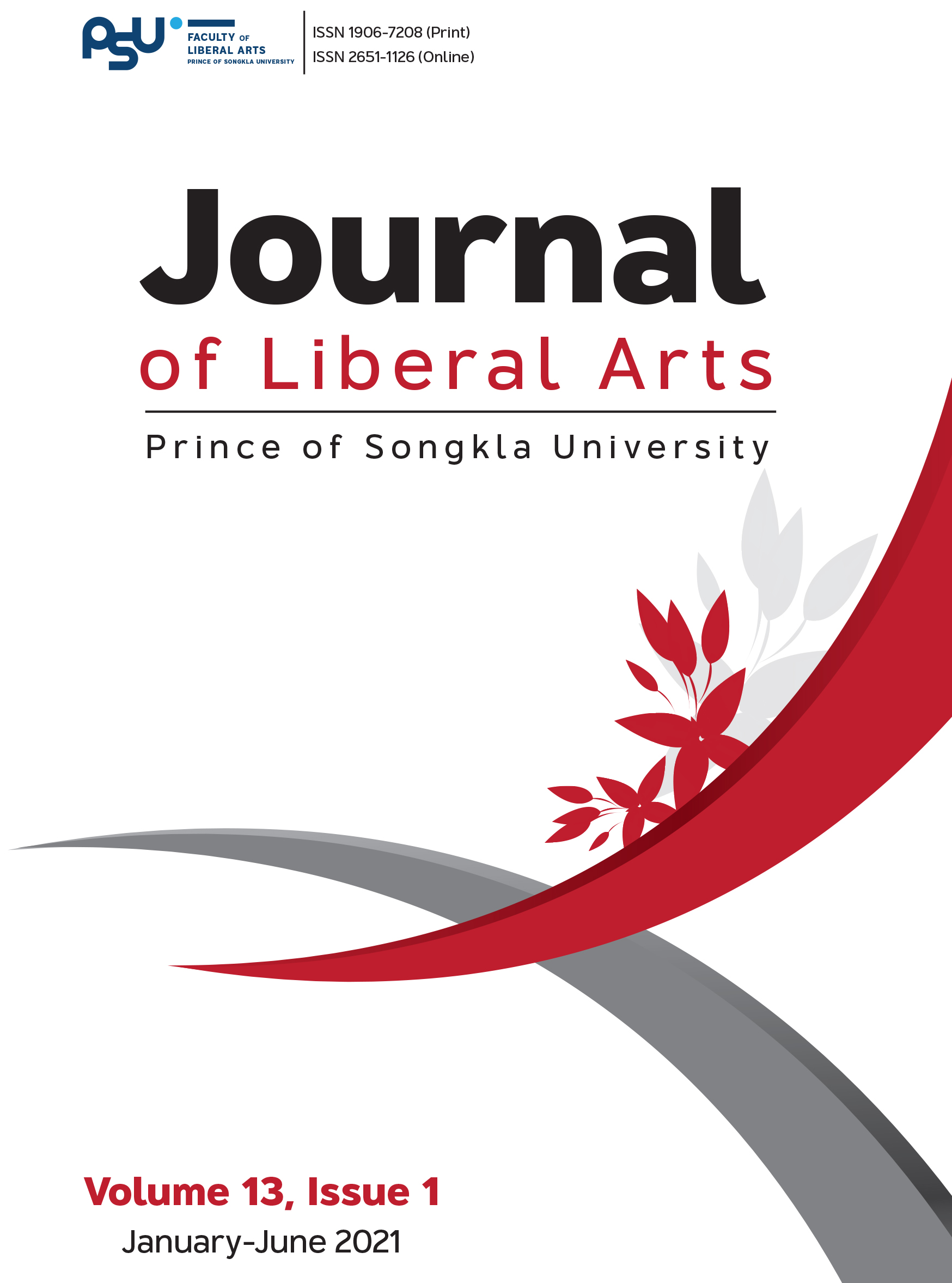วิเคราะห์ความสัมพันธ์ของเพลงกล่อมเด็กมลายูกับสภาพสังคมไทยมุสลิมในยุคปัจจุบัน
คำสำคัญ:
วิเคราะห์ความสัมพันธ์, เพลงกล่อมเด็กมลายู, สภาพสังคมไทยมุสลิมบทคัดย่อ
การศึกษาวิเคราะห์ความสัมพันธ์ของเพลงกล่อมเด็กมลายูกับสภาพสังคมไทยมุสลิมในยุคปัจจุบัน มีวัตถุประสงค์เพื่อรวบรวมเพลงกล่อมเด็กมลายูที่ปรากฏอยู่ในปัจจุบันและเพื่อวิเคราะห์ความสัมพันธ์ระหว่างเพลงกล่อมเด็กกับสภาพสังคมไทยมุสลิม ดำเนินการรวบรวมข้อมูลจากการสัมภาษณ์ผู้ให้ข้อมูลหลัก จำนวน 24 คน วิเคราะห์ข้อมูลด้วยวิธีพรรณนาวิเคราะห์ ผลการศึกษา พบว่า บทเพลงกล่อมเด็กมลายูที่รวบรวมได้ในปัจจุบันมี 110 เพลง เพลงกล่อมเด็กทั้งหมดนี้แสดงความสัมพันธ์กับสภาพสังคมไทยมุสลิม จำนวน 4 ด้าน ได้แก่ 1) ด้านการนับถือศาสนา เช่น การศรัทธาต่ออัลลอฮ ชีวประวัติของท่านศาสดามุฮัมมัด 2) ด้านความเชื่อหรือค่านิยมคุณธรรม เช่น การอบรมให้ทำดีต่อบิดา มารดา ความเชื่อให้ปฏิบัติตามกฎเกณฑ์ของสังคมไทยมุสลิม 3) ด้านการประกอบอาชีพต่าง ๆ ทำนา ทำสวน การประมง หัตถกรรมการทอผ้า และ 4) ด้านวัฒนธรรม เช่น การบริโภคอาหารในชุมชน วัฒนธรรมความบันเทิงนันทนาการ วัฒนธรรมการแต่งงาน วัฒนธรรมการแต่งกาย ทั้งนี้ ในอดีตเพลงกล่อมเด็กมลายูได้รับความนิยมขับร้องในทุกช่วงวัยโดยเฉพาะผู้อาวุโสใช้ขับกล่อมให้ลูกหลานฟังเพื่อความเพลิดเพลิน ปัจจุบันการสืบทอดเพลงกล่อมเด็กมลายูในกลุ่มสถาบันครอบครัวและสถาบันการศึกษาในรูปแบบการขับร้องเป็นสื่อการเรียนการสอนเชิงรุกเพื่อพัฒนาทักษะเด็ก ตลอดจนใช้เป็นเครื่องมือในกระบวนการขัดเกลาสอนคุณธรรมจริยธรรมให้เยาวชนเป็นมุสลิมที่ดีในสังคม
เอกสารอ้างอิง
Chitchinakun, K. (2002). Folklore. Bangkok: Odean Store. [in Thai]
Chokpaisan, S. (1994). Study of the advantages of Southern lullaby KhaoChaison District, Phatthalung Province [Unpublished master’s thesis]. Srinakharinwirot University, Southern Region. Songkhla. [in Thai]
Guba, E.G., (2013).The alternative paradigm dialog.In E. G. Guba. (Ed.) The paradigm dialog. (17-27). Newbury Park, CA: Sage.
Kananurak, M. (1981). Thai Muslim lullaby in Pattani [Unpublished master’s thesis] Srinakharinwirot University. Bangkok. [in Thai]
Khlaisubhan, P. (1988). Folk culture. Bangkok: Sutthisan Printing. [in Thai]
Kongjan, T. (2013). Language characteristics and contents in the Southern lullabies [Unpublished master’s thesis. Silpakorn University. Bangkok. [in Thai]
O-manee, R. (2009). The effect of using lullabies on Thai reading skill of PhathomSuksa IV student at WatMangkalaram School in Nakorn Si Thammarat Province [Unpublished master’s thesis]. SukhothaiThammathirat Open University. Songkhla. [in Thai]
Pakmaluk, S. (2015). I-San local wisdom from lullaby ethnic Thai Lao, Thai Yoy, Phuthai, and Thai Nyaw in SakonNakhon Province. Chophayom Journal. 26(1), 23-34.https://so01.tci thaijo.org/index.php/ejChophayom/
article/view/36916/0
Phongjit, J. (2011). lullabies of Saithongwattana District,Kamphaeagphet Province [Unpublished master’s thesis]. Naraesuan University. [in Thai]
Thawornset, A. (2003). Folklore. Bangkok:Educational Development. [in Thai]
Thongdee, S. (1999). Basic knowledge of human behavior. In S. Thongdee (5th ed.), Humans and Society. (1, 41-47). Sukhothai Thammathirat Open University. Nonthaburi. [in Thai]
Salah, N. (1997). Thai Malay lullaby songs: Language and cultural heritage of Malay People [Unpublished master’s thesis]. Thaksin University. Songkhla. [in Thai]
Sangwachirapiban, S. (2012). Bringing the acuity wisdom of nursery rhymes to interior design project for Kindergarten [Unpublished master’s thesis]. Silpakorn University. Bangkok. [in Thai]
List of interviewees
Pa-sae, P. (2016, November 16). Interviewed by Nipatimah Hayeehama [Tap recording]. Yaring District, Pattani Province. [in Thai]
ดาวน์โหลด
เผยแพร่แล้ว
รูปแบบการอ้างอิง
ฉบับ
ประเภทบทความ
สัญญาอนุญาต
ลิขสิทธิ์บทความเป็นของผู้เขียน แต่วารสารศิลปศาสตร์ มหาวิทยาลัยสงขลานครินทร์ ขอสงวนสิทธิ์ในการเป็นผู้ตีพิมพ์เผยแพร่เป็นครั้งแรก






